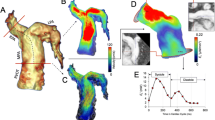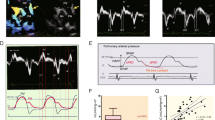Abstract
In Mustard/Senning-repaired (MSR) patients, the right and left ventricles (RV, LV) act as the systemic and pulmonary ventricle, respectively. The purpose of the study was to compare non-invasively, at rest, pulmonary ventricle systolic function and hemodynamics in MSR patients with those of healthy volunteers. Velocity-encoded MR imaging was performed at the level of the main pulmonary artery (MPA) in ten male patients late after a Mustard/Senning correction performed early in infancy and in ten male volunteers. Both blood flow and MPA cross-sectional area variations were recorded over a complete cardiac cycle. MPA distensibility, body surface area (BSA)-normalized pulmonary ventricle systolic power and work were significantly lower in the MSR patients compared to volunteers. In particular, BSA-normalized LV systolic power and work in MSR patients were equal to 82 and 77% on average of those of the RV in volunteers (0.32 vs. 0.39 W/m2 and 0.10 vs. 0.13 J/m2), respectively. We conclude that in MSR patients at rest two unrelated findings were observed: (1) a reduced MPA distensibility and (2) a significantly lower systolic mechanical performance of the pulmonary LV compared to that of the RV in healthy volunteers. The latter quantification indirectly confirms the lowest systemic RV systolic mechanical performance previously published.





Similar content being viewed by others
References
Pennell DJ (2003) Cardiovascular magnetic resonance: twenty-first century solutions in cardiology. Clin Med 3:273–278
Soler R, Rodriguez E, Remuinan C, et al (2003) Magnetic resonance imaging of primary cardiomyopathies. J Comp Assist Tomogr 27:724–734
Weiger M, Pruessman KP, Boesiger P (2000) Cardiac real-time imaging using SENSE. Magn Reson Med 43:177–184
Veraprasathan GA, Araoz PA, Higgins CB, et al (2002) Quantification of flow dynamics in congenital heart disease: applications of velocity-encoded cine MR imaging. Radiographics 22:895–906
Rebergen SA, Helbing WA, van der Wall EE, et al (1995) MR velocity mapping of tricuspid flow in healthy children and in patients who have undergone Mustard or Senning repair. Radiology 194:505–512
Beerbaum P, Körperich H, Gieseke J, et al (2003) Rapid left-to-right shunt quantification in children by phase-contrast magnetic resonance imaging combined with sensitivity-encoding. Circulation 108:1355–1361
Laffon E, Vallet C, Bernard V, et al (2004) A computed method for non invasive MRI assessment of pulmonary arterial hypertension. J Appl Physiol 96:463–468
Swynghedauw B, Carre F (2001) Coeur. In: Guénard H, Bioulac B, Boisseau MR, et al (eds) Physiology humaine, 3rd edn. Editions Pradel, Paris, pp 193–224
Gutberlet M, Boeckel T, Hosten N, et al (2000) Arterial switch procedure for D-transposition of the great arteries: quantitative midterm evaluation of hemodynamic changes with cine MR imaging and phase-shift velocity mapping-initial experience. Radiology 214:467–475
Senning A (1959) Surgical correction of transposition of the great vessels. Surgery 45:966–980
Chang AC, Wernoswky G, Wessel DL, et al (1992) Surgical management of late right ventricular failure after Mustard or Senning repair. Circulation 86:140–149
Lorenz CH, Walker ES, Graham TP, et al (1995) Right ventricular performance and mass by use of cine MRI late after atrial repair of transposition of the great arteries. Circulation 92:233–239
Laffon E, Jimenez M, Latrabe V, et al (2004) Non invasive MRI comparison of systemic hemodynamics in Mustard/Senning repaired patients and healthy volunteers. Eur Radiol 14:875–880
Abolmaali ND, Hietschold V, Appold S, et al (2002) Gadomer-17-enhanced 3D navigator-echo MR angiography of the pulmonary arteries in pigs. Eur Radiol 12:692–697
Laffon E, Valli N, Latrabe V, et al (1998) A validation of a flow quantification by MR phase mapping software. Eur J Radiol 27:166–172
Laffon E, Bernard V, Montaudon M, et al (2001) The tuning of the pulmonary arterial circulation evidenced by MR phase mapping in healthy volunteers. J Appl Physiol 90:469–474
Chemla D, Castelain V, Hervé P, et al (2002) Haemodynamic evaluation of pulmonary hypertension. Eur Resp J 20:1314–1331
Reich O, Voriskova M, Ruth C, et al (1997) Long-term ventricular performance after intra-atrial correction of transposition: left ventricular filling is the major limitation. Heart 78:376–381
Lakatta EG, Zhou YY, Xiao RP (2001) Ageing of the cardiovascular system. In: Sperelakis N, Kurachi Y, Terzic A, Cohen MV (eds) Heart physiology and pathophysiology, 4th edn. Academic Press, New York, pp 737–760
Paul MH, Wessel HU (1999) Exercise studies in patients with transposition of the great arteries after atrial repair operations (Mustard/Senning): a review. Pediatr Cardiol 20:49–55
Roest AAW, Kunz P, Helbing WA, et al (2001) Prolonged cardiac recovery from exercise in asymptomatic adults late after atrial correction of transposition of the great arteries: evaluation with magnetic resonance flow mapping. Am J Cardiol 88:1011–1017
Tulevski II, van der Wall EE, Groenink M, et al (2002) Usefulness of magnetic resonance imaging dobutamine stress in asymptomatic and minimally symptomatic patients with decreased cardiac reserve from congenital heart disease (complete and corrected transposition of the great arteries and subpulmonic obstruction). Am J Cardiol 89:1077–1081
Author information
Authors and Affiliations
Corresponding author
Rights and permissions
About this article
Cite this article
Laffon, E., Latrabe, V., Jimenez, M. et al. Quantitative MRI comparison of pulmonary hemodynamics in mustard/senning-repaired patients suffering from transposition of the great arteries and healthy volunteers at rest. Eur Radiol 16, 1442–1448 (2006). https://doi.org/10.1007/s00330-005-0071-7
Received:
Revised:
Accepted:
Published:
Issue Date:
DOI: https://doi.org/10.1007/s00330-005-0071-7




